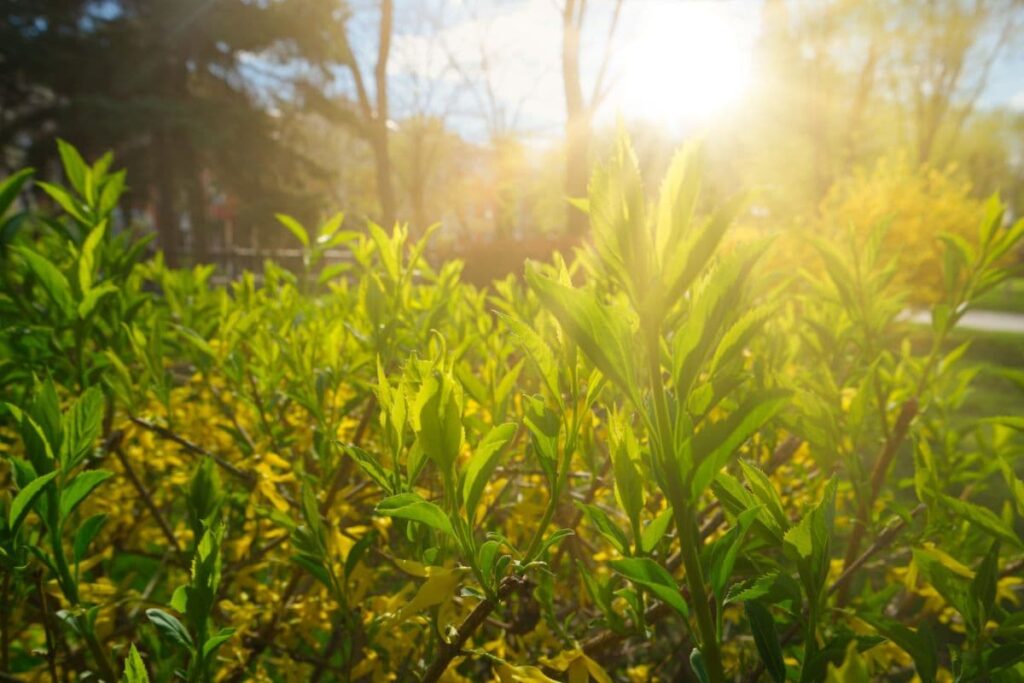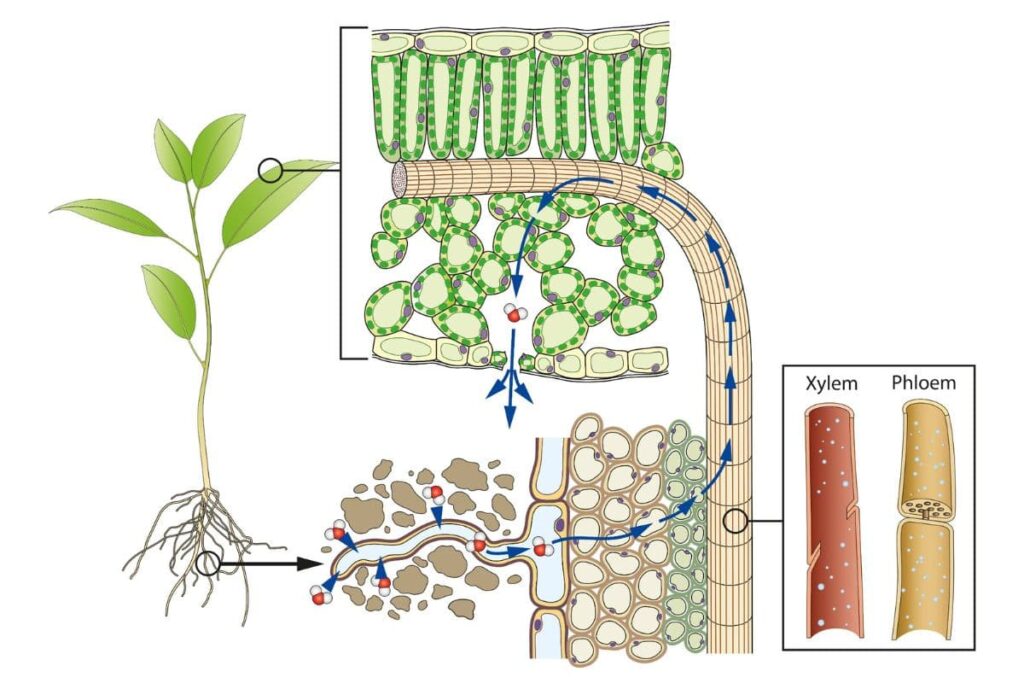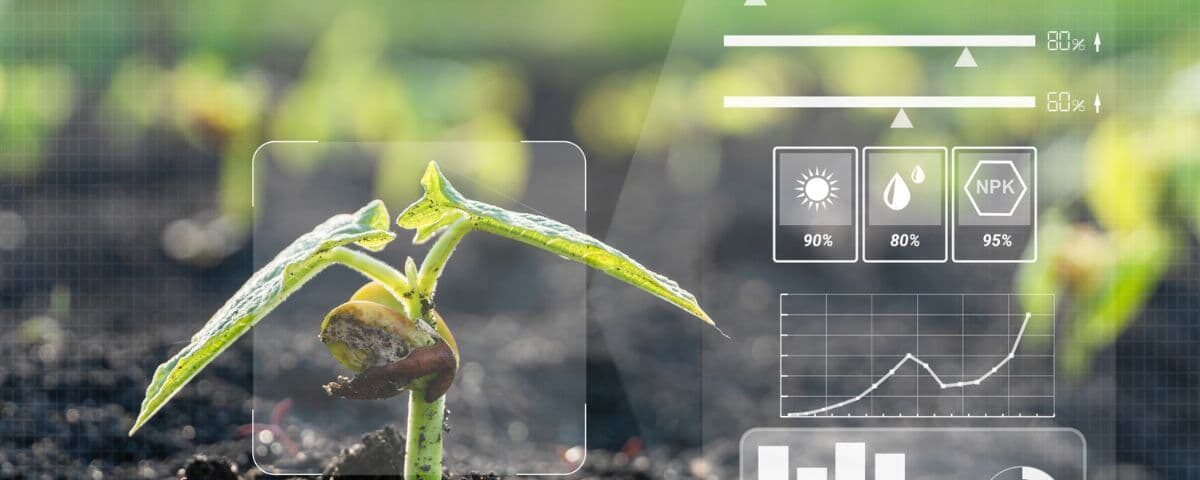|
Getting your Trinity Audio player ready...
|
Plants require six things to grow: space, water, light, air, nutrients, and adequate temperatures. Adequate space ensures roots have ample room to expand. Water, light, and air are necessary for photosynthesis; and nutrients support healthy development and reproduction. But how does temperature affect plant growth?
Does temperature affect plant growth because it is vital to plant processes such as photosynthesis, respiration, and transpiration? Yes, and extreme temperatures can cause stunted growth, plant ill health, and even death. Root temperatures also affect plant growth, as cold temperatures cause poor absorption.
All of a plant’s processes are temperature sensitive, so it’s essential to maintain optimal temperature levels to ensure plant growth. In this article we explain how temperature affects plant growth and vital processes and how to protect your plants from extreme temperatures.
Is Temperature Important for the Growth of a Plant?
Temperature is essential for the growth of plants, as it can limit or increase the growth rate. While an increase in the growth rate may sound ideal, rapid growth may result in unwanted issues. These include poor flowering and lower yield on vegetables.
Maintaining a temperature balance is vital. Temperatures that are too high can cause just as many problems as temperatures that are too low.
How Temperature Affects Plant Processes
Temperature is critical in essential plant processes, including photosynthesis, transpiration, and respiration. Problems with these crucial operations can result in plant growth issues and even death.
Photosynthesis
This process occurs when plants use chlorophyll (the pigment-producing chemical that provides plants with their green hue) to absorb light. Plants absorb carbon dioxide using their stomata (microscopic openings in the leaves).
They then use this energy to create glucose for the plant to feed on.

Photosynthesis is one of the most temperature-sensitive processes in plants.
Respiration
During respiration, plants convert glucose into energy which the plant uses to promote healthy development. Temperature and light conditions affect respiration rates and cause the plant to use more or less glucose.
So, how does temperature affect plant growth when it’s too hot? In moderate to high temperatures, respiration rates increase dramatically. The plant uses substantial energy to maintain respiration instead of plant development. As such, there is an overall decline in plant process efficiency, leading to slow growth.
Additionally, higher temperatures result in the plant using more photosynthates. Growth suffers if the plant cannot produce enough to keep up with usage.
Transpiration
Transpiration is the movement of water throughout a plant. Plants absorb water through the root system and use a small amount in plant processes. The plant releases the rest as water vapour through the stomata.

High temperatures can increase transpiration rates. Extreme high temperatures, however, can slow transpiration as the plant tries to save water as a survival technique.
Cold temperatures can slow transpiration. On the other hand, freezing temperatures can temporarily stop transpiration altogether, resulting in the complete closure of the stomata. If the stomata remain closed for long periods, plants cannot absorb carbon dioxide or form glucose.
Temperature Environments and How They Affect Plants
There is no ideal temperature for every plant, as different species have their preferred conditions.
To determine the best temperature for plants, research the species, and do your best to maintain a temperature balance. Vast fluctuations can lead to various issues, including poor growth. Pay attention to the day and night air temperature, and the root temperature, and watch the humidity.
Air Temperature and Plant Growth
There is no perfect plant temperature, as every plant has its desired range. However, most plants do well with daytime temperatures around 25°C (77°F).
But how does temperature affect plant growth if it’s too high or too low? Well, if it dips below 21°C (70°F) or surpasses 26.7°F (80°F), plants may experience problems with vital processes leading to poor growth.
Slow growth isn’t an obvious problem. There are no telltale signs such as yellowness, curled leaves, or other outward cues signalling disease, so you must use common sense and remain vigilant.
- Monitor your plant environment. Regularly measure air temperature to ensure you’re maintaining optimal levels. 21°C (70°F) to 26.7°F (80°F)
- Keep an eye on the weather forecast. When growing plants outdoors, keep careful tabs on the weather in your area. Check the high and low temperatures daily to ensure you’re not exposing your plants to extreme conditions.
- Plan ahead. If you expect excessively low or high temperatures, you should take steps to keep your plants protected from the elements.
Day and Night Temperatures
Maintaining a balance between light levels and air temperature is critical. If daytime air temperatures are high, but the light conditions are poor, plants produce fewer photosynthates. As such, respiration uses up energy stores quickly, leaving little glucose to dispense throughout the plant for growth.
To prevent this, do the following:
- Provide low light levels and lower temperatures at night. This process reduces nighttime glucose production, allowing the plant to use energy for other vital functions. Photosynthesis picks up again with increased light levels during the day.
- Create some temperature variation between night and day. Don’t make these changes too dramatic. A difference of about 6°C (43°F) is enough to maintain optimal plant growing efficiency. More significant deviations may cause mould and mildew growth and lead to slow growth.
Root Temperature and Plant Growth
Air temperature isn’t the only thing affecting plant growth. Roots are sensitive to temperature changes as well. Problems with temperature can cause significant stress on the plant, cause root damage, and even lead to plant death.
Root temperatures shouldn’t be the same as the air temperature: They should be around 6°C (43°F) cooler. Test the soil temperature using a probe thermometer. If it isn’t close to 6°C (43°F) cooler, you could end up with slow plant growth or other issues such as mould, mildew, and poor water absorption.
To find out how to reduce or increase the temperature of a plant’s soil, check out the tips near the end of this article.
Humidity and Temperature
The warmer the air temperature around your plants, the more water vapour they can hold. Humidity is necessary for plants, but if it’s too high, it can lead to mould, mildew, unwanted pests, or disease.
Optimal humidity levels for most plants are around 50 to 60 percent. If you don’t have an automatic mister or humidifier, use a fan to distribute the moisture evenly to take care of house plants.
Temperature’s Effects on Plant Stages
Temperature affects every stage of a plant’s development, from germination to flowering.
Germination
High temperatures can increase the germination rate, whereas low temperatures can slow it down (or prevent it altogether). Once the seed reaches the ideal temperature, germination activity begins to dwindle, and it is ready for planting.
Cool-season plants, like spinach and broccoli, germinate best in cooler temperatures (13-21°C or 55.4-70°F). Warm-season plants, like marigolds, prefer higher temperatures around 21-30°C (70-86°F).
Vegetative
During the vegetative phase, temperatures too high or too low may cause slow growth, fewer shoots, and poor root development. In vegetables, high temperatures can lead to a bitter taste, as there isn’t enough glucose stored because of the plant’s energy requirements.
Blooming
Inadequate temperatures could cause issues within the flowering stage of a plant. This issue often occurs when people attempt to cultivate plants outdoors outside the plant’s hardiness zone. The plant may grow and survive but won’t flower or seed.
Fortunately, you can control temperatures and other conditions indoors. Learn more about the species you’re attempting to grow to promote flowering. Some require changes in temperature during the flowering stage.
Protecting Plants From Low Temperatures
You may grow plants outdoors and expect a bout of cold weather or grow your plants indoors and want to protect them from a harsh winter. In that case, there are several ways to keep your plants safe and unaffected during low temperatures.
Keeping Indoor Plants Warm
Growing plants indoors gives you much greater control over the growing conditions. However, it can still become cold around the home, whether it’s because of an icy winter or a recent power outage.
These measures will ensure that your plants stay safe.
Keep Plants Away From Windows
Windowsills provide adequate light to most plants, but if they’re not well-insulated, the cold air can negatively affect your plant. Drafts can damage plants as well. If you cover the window with plastic sheeting it will keep out some pf the cold air. Alternatively, move the plants to another location.
Use a Space Heater
If you need a warm room with adequate lighting to keep plants from getting too cold, consider investing in a small space heater. It’s important not to place the heater next to your plants. Instead, keep it several feet away and use a fan to distribute the heat evenly throughout the room.
Knowing how temperature affects plant growth can ensure plants stay healthy.
Use a Plant Heating Pad
Plant heating pads do not heat the air in a room but gently warm the soil. This item is an excellent option for seedlings or root cuttings to keep them warm in cold conditions. These heating pads maintain a constant temperature within the ideal range to promote vigorous, healthy plants.
Keeping Outdoor Plants Warm
Protecting outdoor plants from low temperatures is challenging, as you cannot control outdoor temperatures. However, there are several measures you can take to protect your plants from damage or stunted growth due to low or freezing temperatures.
Bring the Plants Inside
The easiest way to protect outdoor plants from cold weather is by bringing them indoors. However, you should bring them in before the temperature dips too low. Switching a plant from freezing outdoor temperatures to warm indoor conditions can cause stress and shock.
So, keep an eye on the weather forecast. If you’re expecting a cold spell soon, bring the plants inside sooner rather than later so they can adjust better.
Use a Blanket or Plastic Cover
If your plants are too large to take indoors or you have an entire garden planted, you can use a blanket or plastic cover to protect them. Covering the plants creates a pocket of warm air that insulates them and protects them from the cold.
When using plant coverings, avoid touching the leaves and stems. You can use stakes or sticks to prop the blanket up. Remove the cover the next day when the temperature is adequate so the plants can receive sunlight for photosynthesis.
Create a Cloche
You can create individual covers for smaller plants or rows using one-gallon (3.7L) milk jugs by following these steps:
- Cut off about 10 centimetres (4 inches) around the top of the milk jug (including the lid).
- Flip the jug upside down and place it over the plant.
These protect the plant from cold air. When the temperature rises the next day, remove it to allow the plant to receive sunlight.
Watering Tip to Keep Plants Warm
Higher temperatures don’t allow optimal oxygen absorption and increase the risk of disease. Lower temperatures can lead to plant shock, temporarily preventing carbon dioxide absorption and photosynthesis. So, when watering plants indoors or outdoors, keep the water temperature around 22°C (71.6°F).
Protecting Plants From High Temperatures
High temperatures lead to increased plant respiration and stress, which cause a plant’s vital processes to work less efficiently. You’ll need to protect plants from high temperatures to maintain optimal growth.
Keeping Indoor Plants Cool
Your indoor temperatures can fluctuate because of thermostat settings or power outages. Maybe the plant is in a warm, humid environment, such as a bathroom. Either way, there are several ways to keep indoor plants cool to prevent damage and stunted growth.
Keep Plants Out of Direct Sunlight
Avoid placing plants in direct sunlight on a windowsill on scorching days or in extreme climates. Exposure to direct sunlight and heat can lead to scorched leaves and increased plant respiration. Instead, place plants away from the window, or block the excess light with a sheer curtain.
Use a Fan To Distribute Warm Air
If the air temperature is too high, use a fan to circulate the warm air throughout the room. This method helps prevent hot spots and cools down the plants.
If you don’t have a fan, place plants near an open window to provide them with a gentle breeze. That window should face north.
Use a Mister
A cool mist humidifier can keep plants cool and prevent them from getting too hot in warm environments. If you don’t have a cool mist humidifier, pour water into a spray bottle and occasionally mist the plants with water. Keep the water at a temperature around 22°C (71.6°F) for best results.
Keeping Outdoor Plants Cool
When outdoor temperatures skyrocket, it’s tough to keep plants safe. Fortunately, there are several ways to mitigate the effects of high temperatures on your plants.
Water Plants in the Morning
Protect outdoor plants from extreme heat by watering them early in the morning. Watering plants when the sun is at its highest point can lead to scalding.
On sweltering days, you may need to water more than once. However, you should first ensure the soil has adequate drainage. Otherwise, you risk water-logging the plants, leading to root rot.
Use Plant Shades
Excessive heat and sun can cause sun scalding. So, protect plants from extreme heat by blocking direct sunlight with plant shades. Shade cloths are a temporary solution which can prevent plant damage. Ensure there’s enough room for plants to breathe beneath the shade and for important pollinators to access the plants.
Apply Mulch
Mulch holds moisture in the soil and prevents sunlight from penetrating the Earth. This barrier helps keep the soil cool and reduces how often you need to water your plants. You don’t need commercial mulch, either. You can use shredded newspaper, grass clippings, or raked leaves from the previous season to protect plants.
Other Tips for Protecting Plants From Temperature Damage
Besides altering your plant’s environment, there are several ways to avoid temperature damage. Two of the best ways to prevent the effects of temperature fluctuations include:
- Choose your plants wisely. Opt for plants that suit your hardiness zone; they are less likely to suffer from temperature-based damage. Plants native to your area will most likely thrive with no intervention on your behalf.
- Harden off your seedlings before planting them outdoors. Hardening off involves introducing your indoor seedling to outdoor conditions in a gradual manner. This way, you can acclimate your plants to weather such as temperature fluctuations.
To learn more about the hardening-off process, check out this informative Youtube video:
In Closing
Temperature affects plant growth, and both extremes negatively affect the speed and quality of plant growth. You can, however, manipulate plants by controlling temperatures and other variables.
Outdoors, it is more difficult as you cannot control the weather. But, as you have read, there are ways to protect plants from extreme temperatures to ensure optimal growth.

